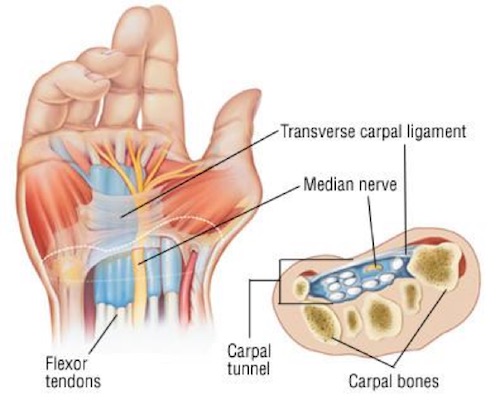What is carpal tunnel syndrome?
Carpal tunnel syndrome is the most prevalent peripheral neuropathy that involves compression of the median nerve during its courses through the carpal tunnel. Entrapment of the median nerve is caused by elevated pressure within the carpal tunnel of the wrist joint, causing a combination of mechanical compression and local ischaemic effect of its contents . An increased volume of tissues or reduction of space are an outcome of elevated pressure that is due to inflammation of flexor tendons, ultimately developing scarring of the median nerve, the tendon sheath or the flexor tendons.
What is the Carpal Tunnel?
Some basic anatomy overview before we go further into the details of the condition. The carpal tunnel is a passageway between the forearm and hand that is surrounded by carpal bones and ligaments. This semi-rigid confined space contains the median nerve as well as nine muscle tendons.

Risk factors of Carpal Tunnel Syndrome
In current research, particular occupations have been seen as a potential risk factor in developing carpal tunnel syndrome 1. It has been demonstrated that the occurrence of carpal tunnel syndrome was present in 57% of cases with relation to work-related musculoskeletal disorders. 39% of the engineering sector workers have the highest incidence of carpal tunnel syndrome. Other occupations included the textile and clothing trade, the food sector, the ceramic industry and construction field 1.
The prevalence of carpal tunnel syndrome is also associated with: age, medical conditions (such as rheumatoid arthritis, diabetes mellitus, pregnancy, obesity, hypothyroidism), and trauma.
It has been shown that Carpal Tunnel also tends to occur more in females than males.
High force and prolonged repetitive movements in flexion and extension of the wrist serves as a risk factor of carpal tunnel syndrome. The use of vibratory tools has also been shown to increase the risk of developing carpal tunnel syndrome. A combination of force grip and hand-held vibratory tools has been reported to increase the risk of carpal tunnel syndrome by double.
Signs and Symptoms of Carpal Tunnel Syndrome
Characteristic symptoms of Carpal Tunnel include:
- Abnormal sensation, also known as paresthesia
- Tingling or Burning sensations
- Numbness or pain along the outer aspect of the palm, thumb, index, middle and inner half of the 4th digit, which is often worsened at night
- Finger weakness, with difficulties in fine movement and grasping objects
On examination, atrophy of the thenar muscles may be observed with loss of thumb strength. These clinical features of carpal tunnel syndrome may be classified into the following three stages (2):
| Stages | Presenting clinical symptoms |
| Stage 1 | • Disruption of sleep at night due to sensation of swelling and numbness of the hand
• Severe pain that irradiates from the wrist to shoulder with tingling in the hand and fingers • Symptoms relieved by hand shaking • Sensation of persistent hand stiffness in the morning |
| Stage 2 | • Symptoms present during the day due to sustained position or repetitive movements of the hand and wrist
• Reports of frequent dropping of objects due to difficulties with pinching or grasping |
| Stage 3 | • Hypotrophy or atrophy of the thenar eminence on examination
• Loss in sensation along median nerve distribution may be present |
How can Carpal Tunnel Syndrome be Diagnosed?
If you are experiencing the symptoms listed above, follow up with a medical professional such as a chiropractor, osteopath, physiotherapist, or your general practitioner, who will be able to assist in the diagnosis and treatment of your symptoms. There are certain tests and examinations that can be performed to evaluate and aid in the diagnosis of carpal tunnel syndrome, including:
- Range of motion tests of the wrist
- Pinch grip strength tests
- Sensory examinations and,
- Manual muscle testing
Provocative or orthopaedic testing should also be carried out to help with the diagnosis of Carpal Tunnel, including:
- Phalen’s test
- Tinel’s sign
- Reverse Phalen’s test
- Durkan’s carpal compression test
- Two point discrimination and,
- Hand elevation test
Treatment options for Carpal Tunnel Syndrome
For patients suffering from mild to moderate carpal tunnel syndrome, studies have shown that conservative forms of treatment have been the most effective. If you are experiencing mild to moderate carpal tunnel, treatment options include:
- Rehabilitation exercises, such as tendon and nerve gliding exercises.
- Paraffin Therapy
- Therapeutic Ultrasound
- Medications
- Manual therapies such as massage
Another management option if suffering from Carpal Tunnel is splinting. Splinting is proven to be one of the most effective management, especially when used in combination with other treatment. Wrist splints are recommended to be worn during night time. Evidence suggests that wrist splint alone, or incorporated with rehabilitation exercise (nerve and tendon gliding), is effective in outcome measures of patients with carpal tunnel syndrome.
Severe cases of carpal tunnel syndrome
If your carpal tunnel syndrome has reached a severe stage, it becomes very hard for practitioners to treat and aid in the relief of pain, and it is then suggested that surgical intervention be taken. Some common choices of surgeries for carpal tunnel syndrome include standard open carpal tunnel release (OCTR), Endoscopic carpal tunnel release (ECTR) and OCTR using various incision techniques.
- Barcenilla A, March LM, Chen JS, Sambrook PN. Carpal tunnel syndrome and its relationship to occupation: a meta-analysis. Rheumatology. 2012;51(2):250-61.
- Alfonso C, Jann S, Massa R, Torreggiani A. Diagnosis, treatment and follow-up of the carpal tunnel syndrome: a review. Neurological sciences. 2010;31(3):243-52.
- Schmid AB, Elliott JM, Strudwick MW, Little M, Coppieters MW. Effect of splinting and exercise on intraneural edema of the median nerve in carpal tunnel syndrome—an MRI study to reveal therapeutic mechanisms. Journal of orthopaedic research. 2012;30(8):1343-50.
